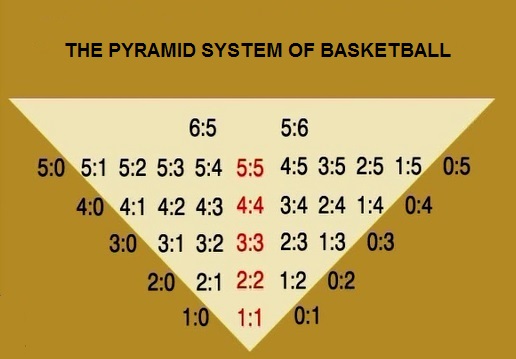The successive, uniform training principles of school basketball
In the instruction of school basketball, a basic requirement is that by applying simplified rules and taking into account the specific features of their age, students can experience a game that corresponds to their skills and prior training.
Through the instruction of basketball, the specific features of the game provide an opportunity to develop the personality in multiple ways.
Among team sports, as compared to other ball games, basketball is characterised by the following features, e.g.:
- the goal or target (the ring) is 3.05 m high and requires aiming in a vertical direction from the ground
- the size of the target is small
- the technical training is strictly rule-governed
- the size of the field of play is relatively small (28 by 15 m); the physical education halls are often smaller in schools
- the time of the performance is influenced by every element of the time rule
- the small area requires a fast performance
- 5-on-5 play requires swift changes of roles (defender from offensive player, offensive player from defender)
Basketball requires a complex activity whose success is influenced by the psychomotor, cognitive (rational) abilities and the affective (emotional) changes.
The instruction of basketball must be done in a uniform manner in every age group, but according to the level of the age, based on the requirements of the curriculum and the sport, realising up-to-date principles, and taking into account the individual differences.
The information and skills related to the sport must be taught in line with the curriculum of the physical education classes in the morning, the material of the mass sport (basketball) trainings must be selected according to the objective of the trainings in the afternoon.
The planning and the selection of the content of the tasks in the training process are essentially determined by the pedagogical objective of the training of this team sport.
The methodology and the objectives of the instruction are different if the afternoon training is done as quality, competitive basketball, or as a sport in the leisure time, aiming at experience (streetball).
Success in the game of basketball requires versatile technical and tactical skills, and the controlled physical training that is specific to the sport, but based on general athletic skills. A style of play must be aimed and formed that suggests momentum, self-confidence and confidence.
In the process of instruction of the basic technical elements and the movements of the basic elements of the game, the following training principles must be applied in the process of instruction, already in the training of beginning basketball players.
- Basketball is a GAME: the playfulness must be kept in practice
- The foundation of skills through playful exercises of skill development
- Practising in situations with the task of decision making
- Instruction in an offensive and defensive unity
- Two-sided training
- The training process of the basic technical and playing elements must be realised in a pyramid system
- Individual, part of team and team tactics, according to the instruction of the age group
- Individual training is a foremost task
The training principles that are consistently and constantly applied accelerate and enhance successful learning.

Mátyás Ránky, 1999
The direction of training:
Intensive, preventive defense, in all forms of defense
- Quick offensive play, based on a lot of running, starts, passes, movements, applying a lot of breakthroughs or dribble penetrations /1:1/, cuts, rationally combined with the play against organized defense, which draws on the various player connections, as necessary /2:2, 3:3 situations, center game, etc./, and an effective shooting set.
- Firm mentality that is ready to fight
- Forming a point of view aiming at achievement.
In line with the direction of training, it provides accents of instruction, and defines the requirements of the level of skills in the particular age groups, as a minimum “mandatory” point of reference in its training process. In the formulation of the requirements, the training and competition experiences of the physical education teacher (coach or trainer) are added; combined with specialized materials accumulated online.